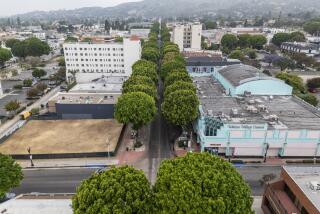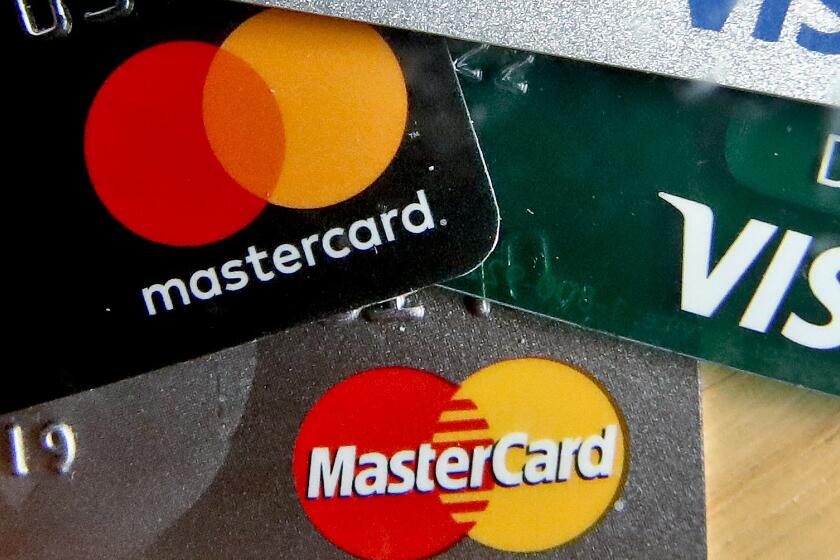Hey, your shade trees are blocking my solar panels
- Share via
One neighbor loves his solar panels, which have cut his energy bill and are helping to combat global warming. The other neighbor adores his trees, which boost his property value and capture greenhouse gases.
So what happens when one guy’s greenery casts a shadow on the other fellow’s solar array?
It’s an environmental battle that’s heating up. And not just on Helms Avenue in Culver City, where the two neighbors -- furniture maker Gary Schultz and architect Michael Rachlin -- have begun using some decidedly un-sunny language to describe each other.
“He’s arrogant,” said Schultz, who installed the solar panels.
“He has been a chronic sort of complainer,” said Rachlin, who planted the stately date palms.
Testy letters and e-mails have been flying between the two. There is talk of litigation.
California has embarked on an ambitious program to install photovoltaic panels on 1 million roofs in California by the end of 2017. So it was perhaps inevitable that property owners, who already fuss with one another about everything under the sun, would end up feuding about that as well.
Complaints are arising from an obscure state law known as the Solar Shade Control Act. It protects homeowners’ investments in solar panels, which can cost tens of thousands of dollars. Property owners whose trees block the sun from more than 10% of their neighbors’ panels can be fined as much as $1,000 a day if they refuse to trim them.
Signed in 1978 by Gov. Jerry Brown, the law was little noticed until this year, when a solar spat ended up in Santa Clara County criminal court.
A judge convicted a Sunnyvale couple of violating the shade law -- an infraction on par with a parking ticket -- for refusing to trim a stand of redwoods that were causing power losses on their neighbor’s solar array. The couple eventually pruned some branches to avoid the fine, but only after spending $37,000 defending themselves in court.
The criminal prosecution attracted international attention and some “only-in-California” snickers. But with more installed megawatts of solar photovoltaic panels than in any other state in the nation, Californians have good reason to take their solar seriously.
Just ask Schultz.
A furniture and cabinet maker who uses lots of heavy equipment at his Culver City shop, Schultz was fed up with Southern California Edison bills that averaged around $5,000 a month -- more than the mortgage on his building
He decided to go solar. Schultz researched the technology and took classes so that he could install and maintain the panels himself. The cost of the 28.8-kilowatt system after the state rebate was $80,000, Schultz said. That’s a hefty sum. But when the system came on line in May 2006, it immediately reduced his power bill to zero.
“I was ecstatic,” said Schultz, 48, a short, stocky surfer who favors T-shirts and shorts. “It was working exactly as I had designed it to work.”
Then came the palms.
Rachlin planted six of them in December 2007 along the property line he shares with Schultz. The 15-foot trees were the exclamation points on his firm’s new headquarters in an abandoned shoe-polish factory, an eyesore turned showplace after a long renovation.
The trees cost $10,000 each to purchase, transport and plant, he said.
“They’re beautiful,” said Rachlin, a dapper man whose knowledge of environmentally friendly building principles has earned him so-called LEED accreditation by the United States Green Building Council.
But one man’s palm-line paradise is another’s power-blocking purgatory. Schultz said his system was producing less electricity than it did before, causing him to write at least $8,500 in checks to Edison this year.
Schultz hired a solar consultant to document his power losses and presented it to Rachlin and to Culver City officials, who Schultz said should never have approved the offending landscaping because it violates the Solar Shade Control Act.
Rachlin said he hired his own expert, who concluded that the palm shading was insignificant and that Schultz’s power losses were a result of poor orientation of his solar panels. Rachlin said he had offered to pay a portion of the cost of relocating Schultz’s panels to a sunnier spot, an offer Schultz rejected because it would require him to make expensive roof reinforcements and because it would make his panels visible to potential thieves.
“I have tried to be a good neighbor,” Rachlin said. “This is just a guy that keeps just coming, coming at you.”
Schultz said he wouldn’t be kvetching if Rachlin hadn’t insisted on planting enormous palms near a solar panel of which he was fully aware.
“He is supposed to be a LEED expert?” Schultz said. “He needs to do the right thing and remove those trees.”
Schultz said that he didn’t want to go to court but that he was prepared to take legal action. Culver City officials are scrambling to come up with a compromise.
Councilman Andrew Weissman said he didn’t think the city was culpable in the flap. Still, he said, there has been discussion about whether Culver City could purchase Rachlin’s trees and relocate them for use somewhere else in town.
An attorney by profession, Weissman said trees have long been the subject of neighbor disputes, be they over leaves littering a swimming pool or roots clogging drainage pipes. But he said this was the first feud that he had heard of involving shade and solar paneling.
“It’s a reflection of how new the technology is,” he said. “It’s an area we’re going to have to pay attention to.”
State rules that take effect Jan. 1 aim to avoid another solar scandal like the one in Sunnyvale. Violations of the Solar Shade Control Act will no longer be considered a crime and will have to be enforced in civil court. And trees and shrubs planted before someone installs solar panels will never have to face the ax, no matter how tall they grow.
Sue Kateley, executive director of the California Solar Energy Industries Assn., sighed when told of the Culver City dispute. She said the solar squabbles, though rare, could deter some consumers from purchasing panels. And she said they detracted from the larger issue of climate change and its potentially disastrous effects on the planet.
“It makes a joke out of the serious business of trying to reduce energy consumption,” Kateley said. “Global warming is real. . . . To diminish it to some kind of barking-dog dispute is sad.”
--
More to Read
Inside the business of entertainment
The Wide Shot brings you news, analysis and insights on everything from streaming wars to production — and what it all means for the future.
You may occasionally receive promotional content from the Los Angeles Times.










